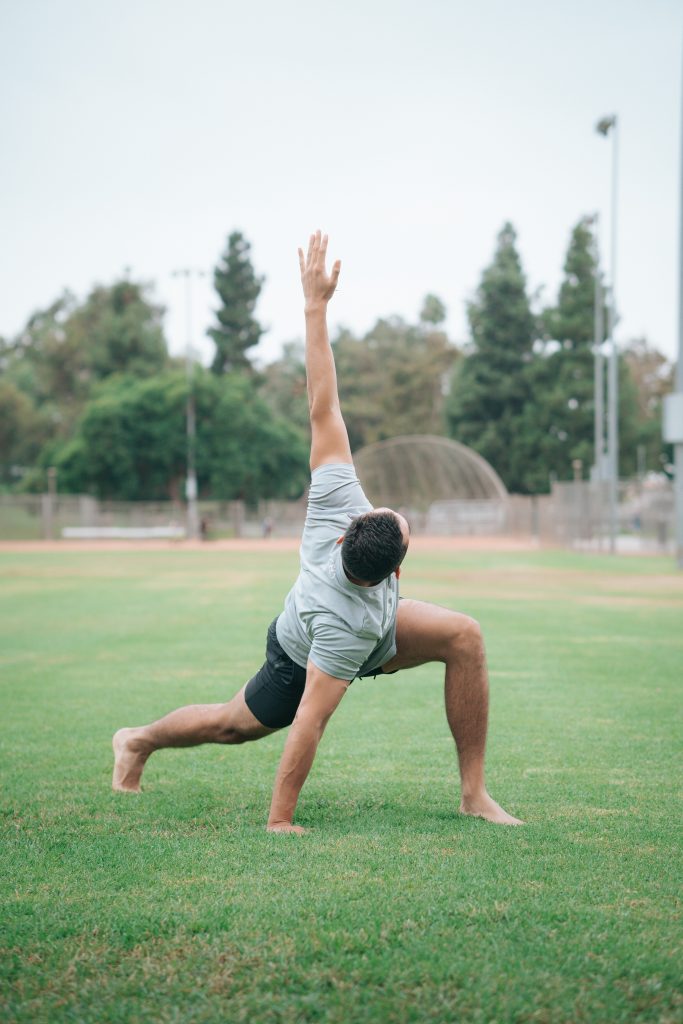Have you been told that it’s important to stretch?
Maybe you heard this from an old P.E. teacher you had growing up. Maybe it was from a doctor, personal trainer, or just a friend that mentioned it. Regardless of who told you, it’s a common recommendation: you should stretch because stretching is good for you.
The need to stretch is said to be even more important if you lift weights. The idea is that, if you strength train, it will decrease your flexibility.
It’s a common idea that I’ve heard from a number of clients over the years.
For example, people make the recommendation to do yoga in addition to weight training, that way the detrimental impact of lifting weights on flexibility is negated.
Stretch your hamstring. Stretch your pec. Stretch your lats. Stretch your toes. Stretch. Stretch. Stretch. Fix the problems weight lifting creates. But is that necessary?
At this point, you’re probably wondering if I’ll tell you to never stretch again. That it’s pointless.
Actually though, I won’t say that, because there is a time and place for it—as I’ll explain later in the blog. What I will say is this: lifting weights, when done using a full range of motion under control, increases flexibility.
Said another way: the idea that weight lifting decreases flexibility is false.
Let’s say though, for arguments sake, that this misconception were true. Then how do we explain Olympic Weightlifters?

If you’re unfamiliar with what I’m talking about, Olympic Weightlifting is a sport in the Olympics in which lifters compete in the Clean and Jerk and the Snatch (pictured above); basically, they lift a metric crap load of weight over their head which requires a crazy amount of flexibility and strength.
So if weightlifting makes people less flexible, then how are Olympic Weightlifters so flexible?
Let’s look at an example to make sense of this.
Olympic Weightlifters
The video below is of Dmitry Klokov doing a snatch at 195 kilograms (429 pounds) and then 200 kilograms (440 pounds). In short, he is really, really scary strong.
Pretty impressive right? The amount of ankle, knee, hip, thoracic, shoulder, and wrist mobility/flexibility needed is insane. Just look at the bottom of the squat and you’ll see what I mean. It’s incredible.
Now, why do I bring that up? To illustrate the main takeaway of this blog: if weightlifting negatively impacted flexibility, then he wouldn’t be able to do those movements.
He can do those movements because strength training improves flexibility.
Now, does this mean he never stretches? Nope. He likely does, to some extent, for sure. But the primary reason he possesses such insane flexibility is that he trains using full ranges of motion under load.
It’s part of why doing deep squats, letting the bar touch our chests during bench press, and deadlifting from the floor (assuming we aren’t experiencing pain in those positions) is a good idea.
You may be thinking that all this is well and good, but are curious of what science has to say about it. Let’s look at some evidence.
Science Stuff
When we look at the research surrounding weight training and improvements in flexibility, it’s promising.
For example, Thrash et al., said: “It was concluded that participation in a similarly structured weight training program to develop muscular strength would not impair flexibility but might increase it.” (3)
The purpose of their study was to determine the validity of the claim that strength training decreases flexibility. As you read above not only did strength training not impair flexibility, they stated that it might improve it.

In a separate study, Monteiro et al, said: “In conclusion, weight training can increase flexibility in previously sedentary middle-aged women in some, but not all joint movements.” (2)
In this study, the joints they did not find significant improvements in were in regard to knee flexion (bending of the knee) and elbow flexion (bend of the elbow). That said, it wasn’t mentioned if they included exercises that maximized these ranges of motion.
My guess is that, if they did include a movement that maximized knee flexion, for example, that they would have seen improvement.
The good news: they saw significant improvements in shoulder adduction, hip flexion and extension, and trunk extension and flexion. Also worth noting is that the control group—the group in the study who did no strength training—showed no improvement in flexibility.
The evidence we have is promising that strength training, when done using a full range of motion under control, can likely improve our flexibility.
Now, what does this look like in action? Let’s take this idea of lifting using a full range of motion and look at a specific muscle group: the hamstrings.
Hamstrings Feeling Tight?
Hamstring tightness is a common sensation that many of us are familiar with. Let’s assume that your hamstrings are tight. As in, the length of the muscle has been decreased. What then? Would stretching help if that was the case?
Yes. And no. Because it depends. I’ll explain.
When most of us think of stretching we think of static stretching, much like in the picture below of the classic hamstring stretch we’ve all done.

Instead of doing the classic hamstring stretch, we can perform Romanian Deadlifts (RDL’s).
Why?
Because when we are performing a RDL we are taking our hamstrings to their end range of motion—meaning, we are stretching them—under load. And, as we’ve discussed so far, moving our muscles and joints through a full range of motion under load helps improve flexibility.
So, we can think of RDL’s as a loaded hamstring stretch. You can see what a RDL looks like in the video below from a guy who sort of, kind of, looks like he lifts. Maybe.
A Final Word On Stretching And A Caveat
Stretching can be a complicated subject—which type of stretching is best, when to stretch—so I want to address those briefly, along with a caveat to this blog.
Let’s start with which type of stretching is best and when to stretch.
Static stretches involve us lengthening a certain muscle, say, the hamstrings, and holding that position.
Dynamic stretching is a more active type of stretch that involves us moving into and out of different ranges of motion—for example, doing butt kicks or high knees.
Ideally, dynamic stretches come before a workout as opposed to doing static stretches. Static stretching has been shown to decrease power production for a period of time after performing them (1). That said, if you would like to do static stretches still, they are likely best suited for after your workout.

Now for the caveat which has been hinted at: this blog is in no way saying not to stretch. If you want to stretch, then stretch away. Stretch your lats. Stretch your glutes. Stretch your imagination. Go for it!
In fact, we include “flexibility and mobility exercises” into our programs at BSP NOVA.
The reason the title of this blog includes “wasting time” is because, unfortunately, I’ve seen people waste a large amount of time stretching when it wasn’t needed—all because they had been misled. They were told they would become less flexible from lifting.
Instead of spending countless hours stretching in fear of losing flexibility from lifting weights, we can ensure we’re using our full range of motion when we lift. As you’ll hopefully see by now, lifting weights using a full range of motion will likely do a better job at maintaining—and improving—our range of motion then stretching alone.
So, if you feel you need more flexibility—in your hamstrings for example—then try incorporating RDL’s into your routine. Tight hips? Try squatting as low as you can control with tension, then spend a few seconds there each rep. Tight lats? Hang at the bottom of a pull-up for a second or two before going back up.
And, by the way, if you’d like help learning how to lift weights effectively using a full range of motion, then fill out the form below to claim your free week. We’d be happy to help!
Sources:
- Cramer, J. T., et al. “The acute effects of static stretching on peak torque, mean power output, electromyography, and mechanomyography.” European journal of applied physiology5-6 (2005): 530-539.
- Monteiro, Walace David, et al. “Influence of strength training on adult women’s flexibility.” The Journal of Strength & Conditioning Research3 (2008): 672-677.
- Thrash, Kevin, and Brian Kelly. “Flexibility and strength training.” The Journal of Strength & Conditioning Research4 (1987): 74-75.
